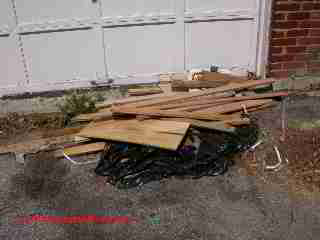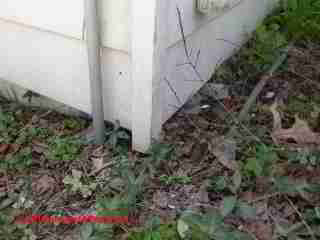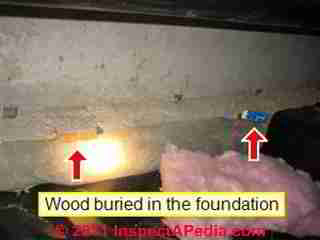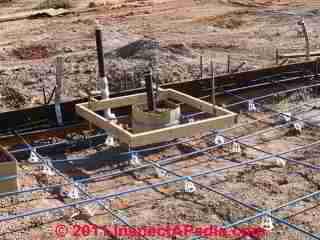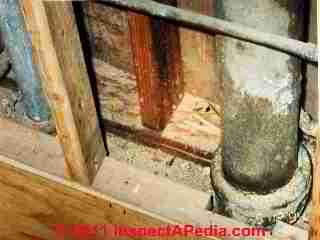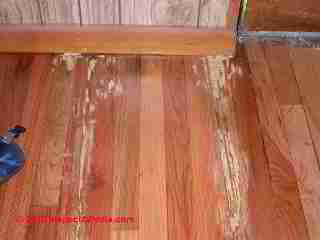 Termite Inspection & Damage Assessment
Termite Inspection & Damage Assessment
Case Report Shows How to Find Termite Damage
- POST a QUESTION or COMMENT about termite inspection procedures & methods
Termite damage asessment guide:
This article provides a detailed case study of a termite inspection that found insect & rot damage: photographs, inspection advice & visual clues that led to discovery of severe hidden structural damage to a building.
These include house damaging mold or fungus, termites, carpenter ants, powder post beetles, & other wood destroying organisms in and on buildings.We are also concerned with choosing mold and insect damage repair and prevention methods which avoid unnecessary application of chemicals or other environmental impacts.
Preventing these problems by good design and by building maintenance is preferred to simple chemical applications around a property. When use of pesticides is required, there are some important choices.
InspectAPedia tolerates no conflicts of interest. We have no relationship with advertisers, products, or services discussed at this website.
Severe Termite Damage Case Study, Inspection Clues, Photographs
This disturbing case study reports a sequence of clues suggesting insect damage, then termite damage, then the discovery of very extensive hidden termite damage in a finished wood floor.
We provide a sequence of photographs showing the course of our termite inspection and what we found.
Outdoor Building Features that Invite Termite Damage Tell Us Also Where to Look for Termite Attacks
Termite trouble signs begin outdoors
The first sign of trouble was that pile of wood flooring and debris by the garage door (photo above), outside the home (photo above left). We later looked through this pile and found it was full of termite-damaged wood flooring.
If we had examined it at first, and had we confirmed it came from this home, we'd have known the story before ever entering the house.
But as you'll see (below) the termite damage "repair" was horrible: it was a cosmetic-only repair intended to sell the home, leaving not only extensive termite damage in place, but the conditions that caused the termite attack had not been addressed nor had a professional termite treatment been performed.
A second sign of high risk of termite damage is shown in our photo above. Aluminum siding came right down to ground level in an area that increased the bug risk by combining roof spillage and in-slope (towards the foundtion) grade. That the owners never raked leaves away and had plantings growing right up to the siding increased the appeal of this home to termites still further.
Add to that risk the observation that when siding touches the ground, insects entering the building behind that siding will remain hidden from view, and we figured this home was sending out an engraved invitation to both termites and carpenter ants.
Examples of outdoor clues that suggest attack by termites or other wood-destroying insects
- Wood close to soil, less than 8"
- Roof drainage spilling against the foundation wall, poor gutter maintenance, downspouts not directed away
- In-slope grade drains towards building
- Shrubs, trees, vines or other plants close to or growing on building siding or walls
See VINES & SHRUBS on BUILDING WALLS, CHIMNEYS - Building foundation insulation extends from below grade to up under or in contact with bottom edge of siding
- No termite shields on foundation tops in termite-prone areas
Question: Do wood forms left between a footing and stem wall increase the risk of a termite attack on the building?
I have inspected new construction home last week. There were some 1x4 wood forms left in between of footing and stem wall.
(Left over footing forms) Is this creating structural or pest problems in future?
Please let me know if I need to do some actions before the house close. Thanks - T.N.
Reply: Yes in many instances. Best practice is to remove wood forms close to or in contact with the soil around a building. Don't leave wood buried around a building.
A competent onsite inspection by an expert usually finds additional clues that help accurately diagnose a problem including evidence of present or prior wood destroying activity at a building (termites, carpenter ants, powder post beetles, carpenter bees, other wood destroying insects (WDI)) or an experienced inspector can cite construction details that increase the risk of a termite or other WDI attack in the future.
That said, for your building and based on the photo you provided (above left) does not look too risky in that there is good visible access to the lower foundation wall to observe any future termite mud tubes or other signs of insect activity.
Watch out: while we have several feet of clearance between the soil top and the top of the solid concrete foundation wall where the first wood framing appears, there could be other termite-attack risk factors not shown in the photo at above-left, including:
Outdoor backfill that is higher on the wall, bringing siding close to ground surface (less than 8") or even below ground level
Voids in the concrete can provide an insect attack path, more-so if no termite shields are used atop the foundation wall, moreso if the the sill plate lumber is not treated wood, and moreso if the area is one where there is frequent termite activity.
In general, I agree that leaving wood forms around footings, slabs, and foundation walls increases the risk of a termite attack.
Our own foundation form photo (left) shows wood forms placed around plumbing drains at a Tucson AZ building site in preparation for pouring the concrete slab. Leaving those forms in place after the slab has cured increases the risk of termite attack, particularly in this location where there may be moisture present around building drains.
Our second termite damage photo (above left) illustrates very extensive termite damage that we found in the sill plates of an interior partition at the center of a New York home.
Notice the close proximity of plumbing lines that penetrated the floor slab in this area?
Ultimately we tracked this termite attack to a combination of forms left in the concrete slab and a heating system leak that sent water into the ground below.
Certainly any wood buried around a building increases the risk of a termite attack - after all, that same approach, burying wood in soil close to a building, is used in the termite bait trap as a method to control termite activity at a property.
The risk of insect attack on a building will be greater if one or more of the following is true:
- The location of the building is one known to be subject to termite or other wood destroying insect activity.
- The distance between the buried wood forms and nearby wood framing is small, perhaps under one meter
- There are hidden or hard to see foundation surfaces such as on the interior of an inaccessible crawl space that would permit the undiscovered presence of termite mud tubes providing a passage for termites between the soil and higher wood framing members.
Incidentally, burying foam insulation close to wood framing or siding can also increase the risk of insect attack on the building as some such as carpenter ants will happily cut through the foam to reach wood materials.
If you can send me photographs or a sketch of the particular wood forms and construction you are asking about I can research further and offer further opinion. Use the CONTACT link found on any of our web pages.
Follow-Up on wood concrete forms and termites:
I spoke with building official this morning and inspector told me that it is ok to buried forms as long as pressure treated. Attached is the picture of foundation footing and stem wall with forming wood in between. I guess this became standard for new construction. - T.N.
Reply:
That's an interesting position and while it is defensible,
I note in your site photo (above left) at the right hand arrow that there is a blue tag appearing to be stapled to the end of the piece of wood - perhaps indicating that the wood is pressure treated and insect resistant, though quite frankly it looks to me as if the tag was added after construction as it 's clean and it's in a position where surely it would become coated with concrete during the footing pour. Take a closer look at the wood for evidence that it was pressure treated.
1. I have not seen a construction project that used treated wood for ordinary foundation forms
2. even if treated wood were used for a foundation form, I am doubtful that the concrete crew followed the treated wood manufacturer's recommendations that include that every single cut needs additional treatment on the exposed cut ends.
3. I have excavated treated wood and found that it is hardly insect proof, it is insect resistant. I have had ample cases of severe termite damage to pressure treated posts, for example.
In sum, in my OPINION leaving the wood forms in place may be "OK" or "legal" with your local code inspectors, but that doesn't mean it's the best practice, nor that you should guarantee the building owners that there won't be a future insect attack through that avenue.
We were on red alert for insect damage before ever entering the home.
Watch out: if you are renovating a building where there has been termite damage, be careful not to disturb and breathe in dust from chemically-contaminated wood. Find out what type of treatment was performed, by whom (was it a qualified licensed pest control company), and where.
...
Continue reading at TERMITE SIGNS INDOORS or select a topic from the closely-related articles below, or see the complete ARTICLE INDEX.
Or see these
Recommended Articles
- INSECT INFESTATION / DAMAGE - home
- INSECTS & FOAM INSULATION
- MERULIPORIA HOUSE EATING FUNGUS - termite & fungus interaction in buildings
- PESTICIDE EXPOSURE HAZARDS
- POWDER POST BEETLES
- RADIANT HEAT MISTAKES FAQs - slab insulation options versus risk of termite damage
- ROT, FUNGUS, TERMITES
- TERMITE DAMAGE INSPECTION
- TERMITE IDENTIFICATION & CONTROL
- TERMITES & NAPTHALENE HAZARDS
- TERMITE SHIELDS vs TERMITICIDE
- VINES & SHRUBS on BUILDING WALLS, CHIMNEYS
- WOOD FLOOR, INSECT DAMAGE
- WOOD STRUCTURE ASSESSMENT
Suggested citation for this web page
TERMITE DAMAGE INSPECTION at InspectApedia.com - online encyclopedia of building & environmental inspection, testing, diagnosis, repair, & problem prevention advice.
Or see this
INDEX to RELATED ARTICLES: ARTICLE INDEX to INSECT DAMAGE
Or use the SEARCH BOX found below to Ask a Question or Search InspectApedia
Ask a Question or Search InspectApedia
Try the search box just below, or if you prefer, post a question or comment in the Comments box below and we will respond promptly.
Search the InspectApedia website
Note: appearance of your Comment below may be delayed: if your comment contains an image, photograph, web link, or text that looks to the software as if it might be a web link, your posting will appear after it has been approved by a moderator. Apologies for the delay.
Only one image can be added per comment but you can post as many comments, and therefore images, as you like.
You will not receive a notification when a response to your question has been posted.
Please bookmark this page to make it easy for you to check back for our response.
Our Comment Box is provided by Countable Web Productions countable.ca
Citations & References
In addition to any citations in the article above, a full list is available on request.
- Best Practices Guide to Residential Construction, by Steven Bliss. John Wiley & Sons, 2006. ISBN-10: 0471648361, ISBN-13: 978-0471648369, Hardcover: 320 pages, available from Amazon.com and also Wiley.com. See our book review of this publication.
- David Grudzinski, Advantage Home Inspections, ASHI cert # 249089, HUD cert# H-145, is a professional home inspector who contributes on various topics including structural matters. Mr. Grudzinski, Cranston RI serving both Rhode Island and Eastern Connecticut can be reached at 401-935-6547 fax- 401-490-0607 or by email to Davidgrudzinski@aol.com. Mr. Grudzinski is a regular contributor to InspectAPedia.com - see DECK FLASHING LEAKS, ROT Case Study, and BASEMENT WATER MOLD IMPACT and VERMICULITE INSULATION for examples.
- Mara and Andy Gieseke, Tucson AZ, are contributors to InspectAPedia.com including photographs used at SIDING EIFS & STUCCO, CONTROL JOINT CRACKS in CONCRETE and ROT, FUNGUS, TERMITES, and are family members of website publisher Daniel Friedman.
- Desert Termites, Thomas W. Fuchs, Extension Entomologist, Darrell N. Ueckert, Texas Agricultural Experiment Station, and Bastiaan M. Drees, Extension Entomologist, Texas Agricultural Extension Service, Texas A&M University System, web search 09/13/2010, original source: http://insects.tamu.edu/extension/bulletins/uc/uc-016.html
- Termites - Greenhouse Gases, U.S. EPA, Environmental Protection Agency. Web search 09/11/2010, original source: http://www.epa.gov/ttn/chief/ap42/ch14/final/c14s02.pdf Quoting an interesting passage from this brief document:
Termites inhabit many different ecological regions, but they are concentrated primarily in tropical grasslands and forests. Symbiotic micro-organisms in the digestive tracts of termites (flagellate protozoa in lower termites and bacteria in higher termites) produce methane (CH4). Estimates of the contribution to the global budget of CH4 from termites vary widely, from negligible up to 15 percent. - Truly Nolen Pest Control, Tel: 866-221-4765, is a national franchise of pest control operators in the U.S. Quoting from the company's website:
Truly Nolen [has] over 80 offices located in Arizona, California, Florida, Nevada, New Mexico, Texas and Utah. The company services more than 150,000 customers and employs about 1,100 partners, with almost 50 percent service technicians. Domestic franchises are offered throughout the United States. International franchises are also established in over 30 countries. - U.S. EPA. Prevention, Pesticides, and Toxic Substances. 1997. Re registration eligibility decision: Diflubenzuron. Pp. 17, 46. www.epa.gov/ pesticides.
- U.S. EPA. Office of Prevention, Pesticides and Toxic Substances. 1994. Pesticide fact sheet: Hexaflumuron. Washington, D.C.
- U.S. EPA. Office of Pesticide Programs. 2003.
Pesticide ecotoxicity database. Unpublished database.
U.S. EPA. Prevention, Pesticides, and Toxic Substances. 1998. Re registration eligibility decision: Hydramethylnon. Pp. 16-18, 43. www.epa.gov/pesticides. - U.S. EPA. Prevention, Pesticides and Toxic Substances. Undated. New chemical New chemical fact sheet: Noviflumuron. Washington, D.C.
- "Protecting Your Home from Subterranean Termite Damage", Journal of Pesticide Reform, Fall 2004, V 24 No. 3, - 6-7, Northwest Coalition for Alternatives to Pesticides/NCAP, POB 1393, Eugene OR, 97440 541-344-5044 www.pesticide.org: Web search 09/11/2010: http://www.hipspro.com/pubs/subterraneantermites.pdf
This document discusses alternatives for termite protection including reducing the attractiveness of the structure to termites (get wood away from the building, fix leaks), use of 16-grit sand (diameter 0.06 - 0.1 in) as a termite barrier 18" wide x 3" deep in crawl areas, or stainless steel mesh for the same purpose under foundations and slabs, boric acid, Diflubenzuron (insect growth regulator, risk genetic damage, EPA classed as carcinogen), Hexaflumuron (insect growth regulator, EPA didn't ID health concerns, waived some testing, partly because of anticipated very low risk of human exposure), Hydramethylnon (stomach toxicant, EPA: Carcinogen, highly toxic to fish), Noviflumuron (chemically similar to hexaflumuron), can cause anemia, EPA didn't ID other health hazards, some testing requirements waived, moderately toxic to fish).
Articles about Rot, fungus, Termites, Carpenter Ants, Powder Post Beetles, Leaks and Water Entry Damage in Buildings
- Basement water entry: what the basement waterproofing companies don't tell you? Water entry prevention and repair suggestions. -- in process
- Building floods how to respond to avoid mold
- Desert Termites, Thomas W. Fuchs, Extension Entomologist, Darrell N. Ueckert, Texas Agricultural Experiment Station, and Bastiaan M. Drees, Extension Entomologist, Texas Agricultural Extension Service, Texas A&M University System, web search 09/13/2010, original source: http://insects.tamu.edu/extension/bulletins/uc/uc-016.html
- Pesticides Contaminate House [PDF] - news article about improperly applied pesticide chemicals and building contamination
- Termite Damage Case Study#1 - exterior clues predicted insect damage; interior access was limited but certain clear clues led right to the damage as well as an attempted cover-up of termite damage below a "repaired" wooden floor. The real evidence was in the driveway. [in process]
- Termite Damage Case Study#2 - very limited visual access inside a building made this inspection for structural damage tough. Outside conditions suggested a risk of water entry and insect attack. Inside the house had mysteriously sloping floors - sloping in every direction. There were few indications of ongoing building movement to explain the sloping. Perseverance led to finding severe termite damage at the building sills. [in process]
- Termites, Wikipedia web search 09/11/2010, original source: http://en.wikipedia.org/wiki/Termite provided some information about termite size.
- In addition to citations & references found in this article, see the research citations given at the end of the related articles found at our suggested
CONTINUE READING or RECOMMENDED ARTICLES.
- Carson, Dunlop & Associates Ltd., 120 Carlton Street Suite 407, Toronto ON M5A 4K2. Tel: (416) 964-9415 1-800-268-7070 Email: info@carsondunlop.com. Alan Carson is a past president of ASHI, the American Society of Home Inspectors.
Thanks to Alan Carson and Bob Dunlop, for permission for InspectAPedia to use text excerpts from The HOME REFERENCE BOOK - the Encyclopedia of Homes and to use illustrations from The ILLUSTRATED HOME .
Carson Dunlop Associates provides extensive home inspection education and report writing material. In gratitude we provide links to tsome Carson Dunlop Associates products and services.


